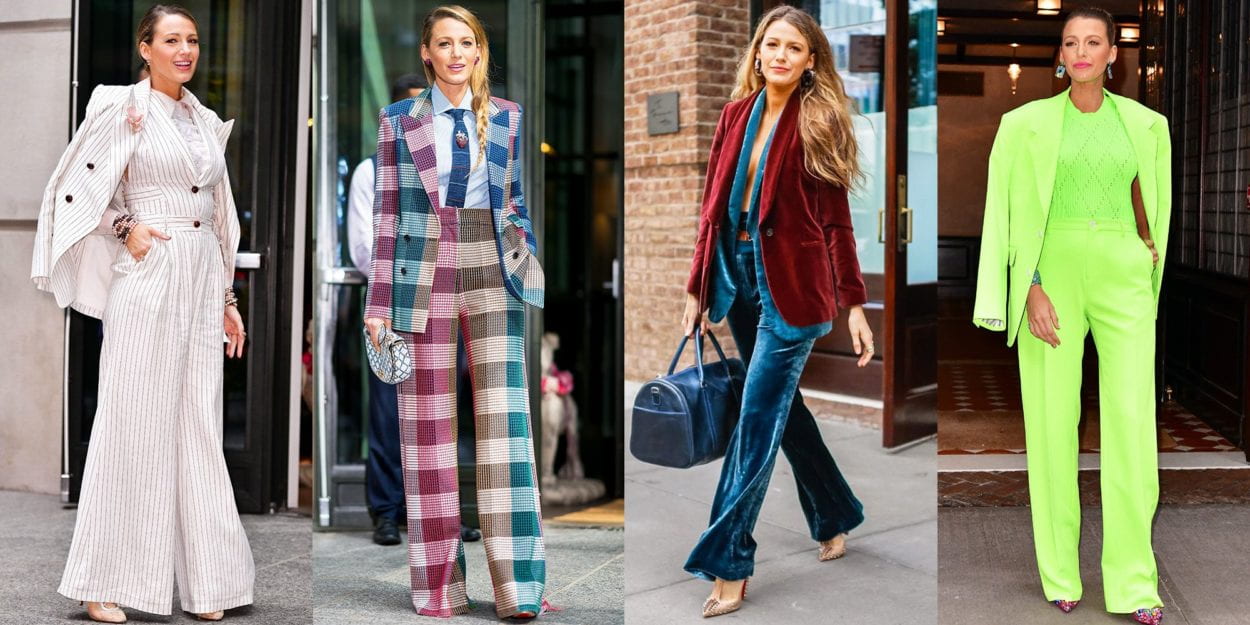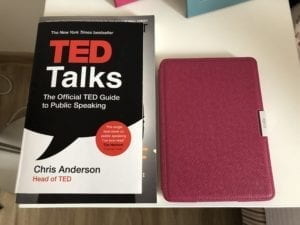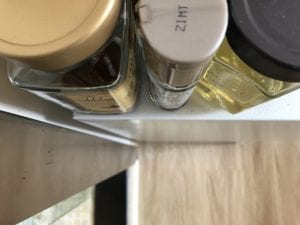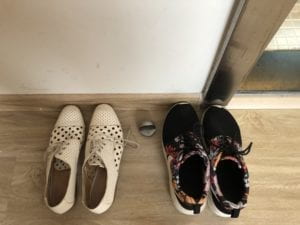I think that the 6 hats workshop was particularly useful and I am definitely going to use this framework one day while working in a group to design a solution to any given issue. During the workshop we did in class, I was a part of the team which had to wear a hat corresponding to feelings. This meant that we had to describe the issue based on empathizing with the prospective user. We tried to understand what kind of emotions were the drivers behind his daily routine and inability to take action and meditate. I found this exercise very useful and thought-provoking because it made me realize how important it is to be able to empathize with users to better understand their needs and motivations.
Final Project Idea /Gabriela Naumnik/
Female suits – where to find them and why don’t they fit well?
Women cannot easily find female suits in stores. Based on many conversations I had with not only my friends but also females I met at different events and women older than me, I see that there is one recurring topic: where are all the fancy and professional female suits? Women want suits they can wear every day as well as suits they can wear to more professional events. However, very few stores offer them and if they do, sizing is often not well-adjusted so that clothes look shapeless. Men have the luxury of being able to go to a suit a store where they can get a tailor to adjust the sizing momentarily. There are no such stores for women.
An app I would use and want to design:
I am definitely not able to create a new brand which would become the next major player in the female clothing industry because at this point in time achieving scale is a barrier to entry. However, what I can do is design an app which would allow professional women to share their female suits inspirations (I would certainly post a bunch of photos of Blake Lively’s from a movie called “A Simple Favor”). My app would not be an online store. Its goal would be to provide inspiration for designers and major brands. Different brands could see which suits suggestions were upvoted by women on the app and choose to design them. Also, women could post their sketches of suits they want or use an in-app outfit assembling function to suggest what they are looking for. Ideally, the app’s users could receive a commission if their suit design was chosen by a brand registered on the platform. The brand could also post some suit designs to check how many upvotes they would have. In the long-run, I would imagine an app like this to be the major source of dialogue between companies and working women so that they could easily suggest and buy the suits they desire.
My goal: an app for working women who want to communicate to designers what kind of female suits they wish to see in stores.
The app: the mobile application would not resemble anything I am currently familiar with. Ideally, it would make profit sharing between women and brands possible, maybe thanks to blockchain.
Design aspects: Commercial Agenda + Problem Solving + Persuasive Design
Inspirations (and dreams):


Tiny Habit /Gabriela N./
Task: Identify one Tiny Habit that you would like to do in your everyday and attempt to design a system around it that would facilitate this behavior. Record and document your process and reflect on it in the blog.
Answer:
What would be my tiny habit?
For my tiny habit, I would choose doing my elliptical training at the exact same time every day instead of working out at different times of the day (sometimes in the morning, sometimes in the evening.
What kind of a system would help me achieve this?
- Motivation – Usually, my motivation is to keep fit and to clear my mind a bit by working out. However, sometimes I lack motivation because I may end working on my assignment late and feel only the need to sleep.
- Ability – My ability to do elliptical training is high because the gym room is in the same building, not very far away from my room. All I have to do is to go downstairs and start the training.
- Trigger – I lack the trigger at the moment. I could use signal as a trigger – simply set up an alarm for the same time every day, for example 9:00 PM.
To sum up, my tiny habit would be tp have a daily time slot for doing elliptical training. To achieve this, I would need to set up an alarm on my phone as a trigger which would remind me to go downstairs and work out every dat at 9:00 PM. In this way, I would feel motivated (not sleepy at this time), I would have the ability to perform the action and the trigger would keep on reminding me to take a break to exercise.
David Rose PPT Reflection /Gabriela N./
David Rose explains how companies want to maximize pixel space which is unfortunate as it is distracting – particularly in China. Here, each elevator is filled with moving screens which makes one feel tired and leads to one being able even to forget what one was doing on an elevator in the first place. For example, certain cities in the West limit the number of ads that can be shown in certain areas. Certain cities in Europe do not allow pixel advertising as it is viewed as a destruction of the natural beauty of cities.
David Rose also talks about robots that look like humans and how creepy that can become. He questions the implicit assumptions designers make that robots should be similar to humans in terms of appearance: why not make them different? Why should such creations make people confused? Animism is a trap, and it makes people feel either confused or annoyed or both. I think that David raises a few high points here: why do people need to assume that new technologies must resemble objects we are already familiar with? I believe that it would certainly make more sense to create, for example, robots which serve a particular purpose but do not necessarily confuse people by looking like them while behaving like zombies. People adjust rather quickly to new technologies. For example, my grandparents grew up without the slightest idea of what an Alexa could be. Now, they are familiar with the concept, they even know how to use such technology.
I definitely agree with his view that certain apps are unnecessary and could be substituted by enchanted objects. I wish I didn’t have to keep on checking my phone so often to either respond to messages or check the news but there are few alternatives if one cannot speak in a public space to Siri. However, I do not agree with all of the proposed ideas. I find the idea of a wallet which controls the outflow of money rather unnecessary as keeping track of one’s expenses with apps seems easier (at least to me). Maybe enchanted objects are not the best solution to each app-based action?
I also think that there are many potential issues with the pill bottle described by David because one does not always sit in the same room, which means that it may be easy to ignore such visual feedback. I guess that my criticism stems from the fact that I know many older people who relocate from time to time and hence, they do not necessarily keep they pill bottles in plain sight. Also, lifelogging praised by the presenter resembles one of the Black Mirror episodes. It’s slightly concerning how often he mentions that companies would benefit from our data.
Overall, I think that enchanted objects had enormous potential and that some of them could indeed be inspired by non-existent tech shown in sci-fi movies. However, we need to bear in mind that technology shown in films can frequently be based on tech unnecessarily resembling objects we are familiar with. I wish I could see more objects which can foster more human interactions, which could stimulate people intellectually and not merely feed us marketing information.
Readings Response + Thoughtless Acts /Gabriela N./
Readings Response
IDEO: The interview with Jane Fulton Suri outlines many observation techniques, including thoughtless acts. This reading made it clear to me that great designs often result from one’s ability to observe actions that people do subconsciously and rather mechanically, Jane shows many photos of people who use their fingers as bookmarks or people who try to read a large newspaper while laying down on their back. She also shows examples of people lining up along a wall for no obvious reason. This article made me reflect more on thoughtless acts that can be observed at NYU Shanghai, some of them could include people constantly not topping up their NYU cards only to later spend a few minutes in a long payment line at the cafeteria instead of choosing to top up their card and pay within seconds by tapping on the counter. More NYU Shanghai students decide not to spend around 30 seconds on topping up their cards only to later spend comparatively more time waiting in a check-out line. It indeed does not make much sense but people do it nevertheless. This could serve as a start point of designing a new solution aiming to solve the long line issue.
AFFORDANCES AND CONSTRAINTS: Affordance is a way of using something, perceived affordance is how one thinks something may be used, conventions are learned, and constraints indicate limitations of a given action. I believe that one of the most popular conventions is a turn on/off sign which can be represented by a circle with a line coming through it. It is a learned convention. As someone who barely remembers life without computers, whenever I see the turn on/off sign, I know exactly what to do. However, my grandmother may still struggle with which button to press on an electronic kitchen plate as she grew up prior to the introduction of the universal symbol. So the symbol convention is something that I have learned but is also something my grandparents may struggle with. Even though the reading emphasizes the difference between affordances and conventions, I would like to argue that in the case of the turn on/off switch the convention and the affordance are similar in my case. This is because to me, there was no difference between learning how to use a mug and as turn on/off switch. In contrast to my grandma, whenever I see such a symbol, I know exactly what to do. In the world of rapid technological progress, can certain conventions become affordances? This is one of the questions the reading left me ponder.
Thoughtless Acts
MY COMMON THOUGHTLESS ACTS: I’ve realized that I make a lot of thoughtless acts such as lining up my books with the border of the nightstand, placing objects on my laptop so that all the lines are perpendicular and parallel to each other, placing my jars along the edge of my mini fridge and even making sure that one of the shoes is directly in front of a metal panel on my wall. Why do I behave in this way? I would speculate that it is because I like to keep my surroundings clean because it gives me a sense of order.



MY LESS COMMON THOUGHTLESS ACT: However, one of my most interesting thoughtless acts includes placing a plastic cotton buds cup in a material strap adjacent to my vanity bag. Now that I think of it, I did it because I wanted to make sure that I can use efficiently the limited space of my dorm bathroom:
